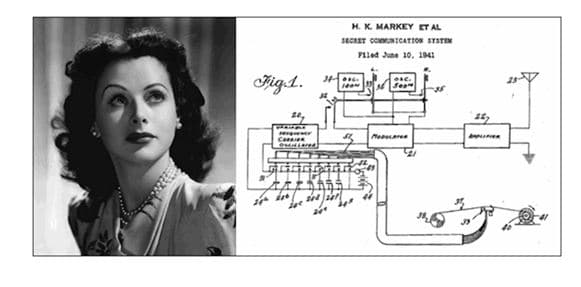Cocktail Party Physics: A Hop, Skip, and a Jump (or, the Origin of Frequency Hopping)
Wayne Staab and Steve Armstrong
(Or, the Good, the Bad, and the Ugly – for an explanation, read the end of this blog)
Frequency hopping has been discussed in this series of posts related to Bluetooth as its underlying foundation. Several persons are credited with inventing frequency hopping.1 The first was Johannes Zenneck (1908), a German who is on the record as stating that his company, Telefunken, had already invented the technology. Later, in 1929, the Polish inventor Leonard Danilewicz is said to have developed the idea separately.
However, the more interesting and exotic version is credited to the Austrian actress and mathematician Hedy Lamarr (along with her pianist-neighbor George Antheil) as a co-originator of the idea that led to a patent submitted in 1941 and granted in 1942 based on spread spectrum transmission, or frequency hopping.

One of the most provocative film stars of Hollywood’s golden age, Hedy Lamarr was the co-inventor of wireless “frequency hopping,” which is used to this day for secure military radio communications as well as for other modern spread spectrum communication technology. U.S. Patent No. 2,292,387.
Lamarr had been married to an Austrian industrialist and arms manufacturer who was so controlling that she was forced to accompany him on many of his business trips. As a result, she was exposed to plans and discussions of remote-controlled torpedoes. These were never produced because the guidance system was too susceptible to disruption. In 1937, before WWII broke out, Lamarr, who was already a known actress, left Austria and her husband and signed with MGM in the United States.
In 1940, she met George Antheil, a California neighbor, pianist, and composer who had experimented with automated control of musical instruments. During a cocktail party, wanting to assist in the Allied war effort, they discussed the fact that radio-controlled torpedoes, important to the navy, could easily be jammed by broadcasting an interference at the frequency of the control signal, causing the torpedo to miss its target.
She explained to him her idea of distributing a torpedo guidance signal over several frequencies, thus protecting it from enemy jamming. The final element was how to employ a synchronized signal between the transmitter and receiver.
Frequency Hopping
They developed the idea of using a frequency-hopping presentation to avoid jamming. This was based on using the 88 frequency keys of the piano to control the frequency hops. George would play a note on the piano and Hedy repeated it on another scale. She realized by doing this that communication could be established, providing they made the note changes at the same time (in a pattern known to both of them).
Translating this to the torpedo discussion, the identical specific code for the sequence of frequencies would be held both by the controlling ship and in the torpedo. This encrypted the signal, which made it practically impossible for the enemy to scan and jam all 88 frequencies. The frequency hopping was controlled by a player-piano mechanism, using perforated paper rolls between two pianos that would turn in synchronization with each other. This provided a system of transmitting and receiving ever-changing frequencies, and thus, would prevent jamming and interceptions.
An example of its use is as follows: If a sent torpedo was controlled by a continuous signal, the enemy could identify the signal, and in turn, insert a high noise to force it off its course. However, if the sending transmitter and receiver in the torpedo jumped from one frequency to another, if any of the frequencies were to receive interference, other channels in the sequence of jumps would not be interfered with.
In 1942, unknown to the public, Lamarr (then Markey) and Antheil received a patent and gave it to the United States government as a “Secret Communications System” expressly constructed to assist in the defeat of Hitler. Interestingly, the U.S. Navy opposed the idea and did not adopt the system during the war, but did commission a project to acoustically detect submarines using sonar buoys remote-controlled from airplanes in the 1950s.
Their communication system was not implemented in the USA until 1962, when it was used by U.S. military ships during the Cuban Missile Blockade after the patent had expired. However, rather than being used for torpedoes, it was used to provide secure communications between ships used in the blockade.
No one made any money from Lamarr and Antheil’s invention or from their patent, which eventually expired. Then, in the 1950s, Sylvania2 introduced a similar concept and coined the term “spread spectrum.”
Today, the frequency-hopping science presented in the patent serves as the basis for modern spread-spectrum communication technology (Bluetooth, Wi-Fi, etc.) used in cell phones, pagers, wireless Internet, defense satellites, and many other spread-spectrum devices. Instead of “frequency hopping,” today’s term is “spread spectrum,” but the basic idea is the same.
Comment on “The Good, the Bad, and the Ugly.” This was an alternate title considered by the authors. The “good” referred to the concept, the “bad” related to the U.S. Government’s head-in-the-sand refusal to take this seriously until years later, and the “ugly” should be obvious to anyone looking at the lovely photo of Hedy Lamarr, and then casting their eyes to the right showing the photos of the authors. She is obviously NOT the ugly!
(Next week’s post will conclude this series on Bluetooth 101, which concentrated primarily on general concepts in Bluetooth. It will comment briefly on Bluetooth architecture. A following series will relate Bluetooth and other wireless connections to hearing aid devices.)
References:
- https://www.tech-faq.com/frequency-hopping-spread-spectrum.html
- https://hypatiamaze.org/h_lamarr/scigrrl.html






